| Author |
Message |
Kirk Lee Spencer

|
 Posted: Fri 29 Apr, 2005 8:22 pm Post subject: Wire Binding on Viking Swords Posted: Fri 29 Apr, 2005 8:22 pm Post subject: Wire Binding on Viking Swords |
 |
|
While browsing the shelves of "Half Price Books" I found an interesting survey book on the Vikings. It is entitled "Vikings: The North Atlantic Saga" ed. William Fitzhugh and Elisabeth Ward. (Forward by Hillary Rodham Clinton  ) )
There were a few interesting pictures of Viking swords... a couple I had never seen with wire grips still in place. This got me to thinking that the Viking Sagas mention swords being bound in silver. I envision the grips being bound with silver wire. However I have seen very few Viking swords with wire grips. However the non-ferrous wire should be preserved even if the wooden core has rotted away. The fact that a few swords have the wire wrapped tightly around the bare tang suggests that the loose wire may have been found with the sword and was simply coiled around the tang by the person who found the sword. I wonder how many Viking swords were found with the wire and the time was not taken to preserve the wire with the sword. I am also suprised by how many Viking swords in Ian Peirce's "Swords of the Viking Age" have the twisted wire decoration on the pommel missing. Another observation is that it seems that the pommel wire is either all there or it is all missing. This suggests to me that maybe, on some swords, the wire was removed before the sword was buried or sacrificed to the lake or bog. If so the wire of the grip may have been taken also. So there may have been many more Viking swords "bound in silver" then what we see in collections today.
Another observation is that the wire binding on the type S sword seems to be twisted at intervals so that when wrapped around the grip it produces alternating twisted and untwisted sections. Thinking about how the pattern welded blades were made, you see a similar twisted and untwisted section of the rods which also produces alternation straight and pattern portions of the blade. See and example here:
http://www.templ.net/pics/v_b19v.jpg
ks
 Attachment: 92.76 KB Attachment: 92.76 KB
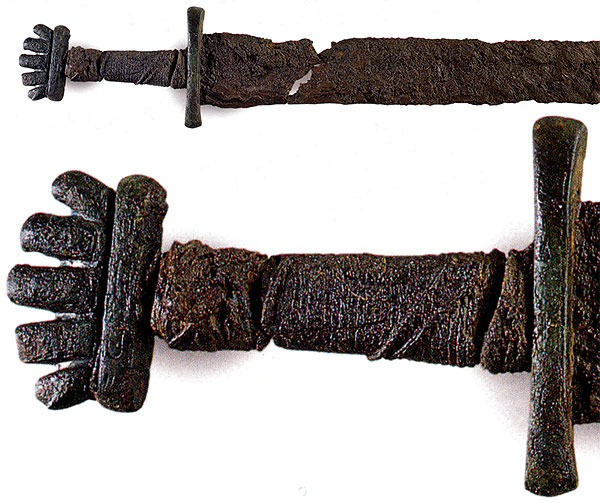
 Attachment: 99.19 KB Attachment: 99.19 KB
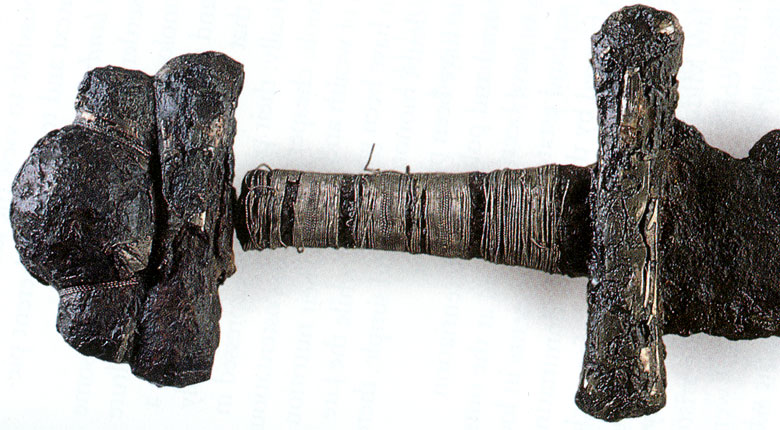
 Attachment: 99.9 KB Attachment: 99.9 KB
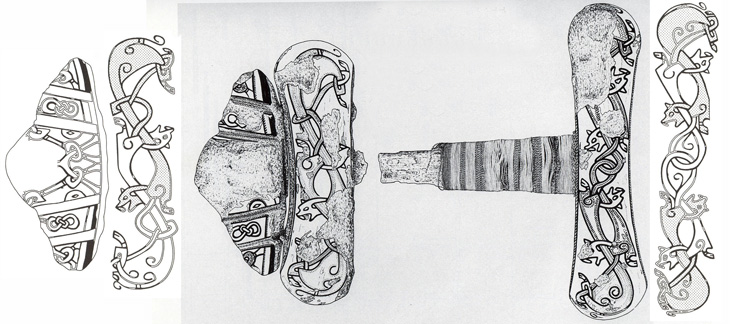
Two swords
Lit in Edenís flame
One of iron and one of ink
To place within a bloody hand
One of God or one of man
Our souls to one of
Two eternities
|
|
  |
 |
|
Patrick Kelly
|
 Posted: Fri 29 Apr, 2005 8:33 pm Post subject: Posted: Fri 29 Apr, 2005 8:33 pm Post subject: |
 |
|
If the wire on a swords pommel assembly is missing it's more than likely due to the method of construction than from any intentional act. These wire decorations were not soldered or otherwise permanently affixed. They were pressed into place and held firm by a friction fit. They may have fallen out during use in the swords lifetime, or possibly could have come loose due to the deterioration of the hilts surface. There's absolutely no evidence to support the theory that they were intentionally removed.
As for swords with the wire wrapped around the bare tang: I highly suspect that this was either done by the person who found the sword during excavation, or by a museum employee who decided it looked better that way, or by a victorian era collector who decided to dress up his antique. In the latter two cases the wire may not even be indigenous to the sword.
"In valor there is hope.".................. Tacitus
|
|
   |
 |
|
Russ Ellis
Industry Professional
|
 Posted: Fri 29 Apr, 2005 9:26 pm Post subject: Posted: Fri 29 Apr, 2005 9:26 pm Post subject: |
 |
|
I agree with Patrick, that probably in a lot of cases where you see wire wrapped around a bare tang that the wire was probably not original to the sword. Not saying it is impossible but... The other thing to remember is that wire was extremely hard to make at the time so it probably wasn't all that common? When I think if hilts "wrapped in silver" I tend to think of the may examples I've seen in books where thin silver sheets were hammered into incisions on the iron hilt components of the swords.
TRITONWORKS Custom Scabbards
|
|
  |
 |
|
Patrick Kelly
|
 Posted: Fri 29 Apr, 2005 9:34 pm Post subject: Posted: Fri 29 Apr, 2005 9:34 pm Post subject: |
 |
|
| Russ Ellis wrote: | | When I think if hilts "wrapped in silver" I tend to think of the may examples I've seen in books where thin silver sheets were hammered into incisions on the iron hilt components of the swords. |
I agree with this and think it's a far more likely explanation.
"In valor there is hope.".................. Tacitus
|
|
   |
 |
|
Shane Allee
Industry Professional
Location: South Bend, IN Joined: 29 Aug 2003
Posts: 506
|
 Posted: Sat 30 Apr, 2005 8:03 am Post subject: Posted: Sat 30 Apr, 2005 8:03 am Post subject: |
 |
|
We do have a few examples of thin grips on swords from the Viking age, for example we know the Lough Derg sword from Ireland has the two long ferrules that take up most of the grip area and are very thin. Then we have swords like the Temple Church sword in the British Museum that have wire wrapped grips, but looks like it isn't in found condition. With this one, you have the wire wrapped around the tang, but also two braided wire ferrules that are normal grip size. So maybe the wire was wrapped around a wood core and was just wrapped around the tang after it was found, or maybe it was added to dress it up in modern times.... We really aren't going to know about something like that unless there turns out to be a dig report or something. On the other hand there seems examples of wire wrapping that are close to the tang on the sides, but have gaps on the front and back. Since we do know that narrow tangs were sometime used in period, one option might be that some of these had only the slightest bit of organics on the sides or just organics on the large flats of the grip. So a sandwich style construction held in place by the wire.
While I don't think that wire thickness would be affected so much, we must not forget that gold and silver can be under the right conditions, can have things happen to it in the ground. Over time water eat away at them and redeposit it in other locations. The last few years I recall seeing a couple examples of silver dots on blades where either a small amount of silver was used on the hilt or a piece was placed near the sword at the time of deposition.
One of the problems of stripping a wire wrap off of a viking age sword I have is the fact that the value of the sword would most likely be the same, probably more than the little bit of silver taken.
As well, we always have to remember when we read something was wrapped with, bound in, etc that if it was an early text it has been translated one if not multiple times.
Shane
|
|
    |
 |
|
Jim Post
Location: Madison, WI Joined: 22 Sep 2003
Posts: 10
|
 Posted: Sat 30 Apr, 2005 8:16 am Post subject: Posted: Sat 30 Apr, 2005 8:16 am Post subject: |
 |
|
| Patrick Kelly wrote: | | If the wire on a swords pommel assembly is missing it's more than likely due to the method of construction than from any intentional act. These wire decorations were not soldered or otherwise permanently affixed. They were pressed into place and held firm by a friction fit. They may have fallen out during use in the swords lifetime, or possibly could have come loose due to the deterioration of the hilts surface. There's absolutely no evidence to support the theory that they were intentionally removed. |
Nor is there any evidence that I'm aware of to refute the theory. Consider: Silver was a valuable commodity. Reusing wire from a broken sword would simply make sense, if the wire was still in good shape. Since wire wrapping could loosen, the more valuable the wire, the more likely it would be reused.
About silver inlay being the "wrapping," that is entirely plausible. The Vikings used very colorful language when naming things. But it is equally plausible that a sword "wrapped in silver" did mean just that, at least, that the grip and perhaps pommel and guard were, indeed, wrapped in silver. Drawing wire is a pretty low tech procedure and silver is softer than iron. I don't see why silver wire wrapping is any less likely than silver inlay.
Any thoughts?
Jim
World's second-youngest curmudgeon
|
|
  |
 |
|
Peter Johnsson
Industry Professional
|
 Posted: Sat 30 Apr, 2005 11:37 am Post subject: Posted: Sat 30 Apr, 2005 11:37 am Post subject: |
 |
|
There are enough swords with silver wire wrap surviving that we can know some about this. The interesting hint it gives us is that at the later viking age it seems to be fairly common with very slim grips on some hilt types. In some cases the wire has been rewrapped or at least re-wound around the tang at restoration, but enough survive intact for us to see that there was not that much material between the tang and the wire; only very thin slats of wood (usually four, one on each side of the tang, sometimes two slats in a sandwich construction).
There are swords with surviving grips not bound in wire that are also very thin, or narrow, so this shows a trend. To my mind it seems to be more common towards the 11th C. Earlier on grips were wider but flat instead. I must ask for some caution with this observation, because it is based on a small number of surviving sword grips. There is a trend though, I think.
Some of the illustrations Kirk has posted shows very clearly how grips could have looked with alternating twisted and untwisted portions. The same effect you see on some well preserved knife grips that often can have a "ferrule" towards the blade made up from twisted wire, looking exactly like this (Wire bound around a section of the wooden grip, sometimes the wood beneath the wire is grooved to create a textured surface of the wire bind, much like some 16th & 17th C rapier grips).
When the texts talk about a hilt wrapped in silver we could well believe it is exactly that. Sometimes the term is more uncertain, like silvered or silver encased. In those cases it could be a hilt with furniture embelished with silver with or without a silver wire wrapped grip.
|
|
   |
 |
|
Patrick Kelly
|
 Posted: Sat 30 Apr, 2005 4:31 pm Post subject: Posted: Sat 30 Apr, 2005 4:31 pm Post subject: |
 |
|
| Jim Post wrote: | | Nor is there any evidence that I'm aware of to refute the theory. Consider: Silver was a valuable commodity. Reusing wire from a broken sword would simply make sense, if the wire was still in good shape. Since wire wrapping could loosen, the more valuable the wire, the more likely it would be reused. |
That's true. However, using the absence of evidence as a source of validation is no way to substantiate a theory. True, silver had value. True, the ancients were great recyclers. On the other hand, we have many, many other items that have been included in grave goods that were made from other valuable metals, including gold, bronze, and iron. Everything from belt fittings to butt caps have been found. Nor were weapons the only things put into bog deposits. Logically there's no reason why these items would have been surrendered to the ages whereas a strand or two of silver wire was too valuable to lose.
When we try to substantiate theories we can take two routes: that of logical deduction, or that of "we can't disprove it so anything goes". I'll leave it to you to decide which is the better avenue.
"In valor there is hope.".................. Tacitus
|
|
   |
 |
Kirk Lee Spencer

|
 Posted: Sat 30 Apr, 2005 8:50 pm Post subject: Posted: Sat 30 Apr, 2005 8:50 pm Post subject: |
 |
|
| Patrick Kelly wrote: | | Jim Post wrote: | | Nor is there any evidence that I'm aware of to refute the theory. Consider: Silver was a valuable commodity. Reusing wire from a broken sword would simply make sense, if the wire was still in good shape. Since wire wrapping could loosen, the more valuable the wire, the more likely it would be reused. |
...Logically there's no reason why these items would have been surrendered to the ages whereas a strand or two of silver wire was too valuable to lose.
When we try to substantiate theories we can take two routes: that of logical deduction, or that of "we can't disprove it so anything goes". I'll leave it to you to decide which is the better avenue. |
Hey guys.,
Thanks for all the feedback...
Lets say that there are not only Patrick's two routes, but rather three ways to argue:
1. Deductive (from a general conclusion to particulars),
2. From silence ("we can't disprove it so anything goes" or "we do not know of any evidence against" this presupposes relative complete knowledge which is not usually true of archeology)
3. From authority (with statements like "Logically there is no reason why..." and "There's absolutely no evidence to support the theory...")
I think arguments from authority have some merit, but they seem to shut down any future discussion especially those lurkers who would not consider themselves "authorities".
Arguments from silence also have some merit, as long as everyone is clear on what kind of argument it is and how large or small the sample size is on which the lack of evidence is based.
I would agree deductive argument is the best route to take...
My initial post was just to share some interesting pictures and an oddball idea... (I really didn't think it would be that controversial.) Archeology is, after all, a forensic science... so in the tread starter I did offered a few clues (if not deductive argument and evidence). Let me try to explain the logic again:
I started with the observation that there were swords with grips bound in silver wire (I posted pictures of a few)
Then I mentioned Viking Sagas describing swords as "bound in silver." I believed that this could possibility refer to silver wire grips as well as all the silver inlay on pommel and guards.
From this I derived the general conclusion from which deductions would be made. That conclusion was that wire wrapped grips were possible more common than we suppose.
The first deduction:
We should find the wire with the grips because they are non-ferrous and should survive. However it is very rare to find wire on the sword grip (although it does happen)
This led to my second general conclusion (the controversial one): Maybe the wire was there and was removed before burial. The problem is that we do not know if there was wire on the grips to begin with. However we do know there was some twisted wire on the pommel for there are grooves into which the wire was fit.
Here is the clue (or evidence) I tried to bring into play from Ian Peirce's book (it is the only source I could find of a relatively large number of sword pics and stats.) I said that it suprised me how many of the swords that had twisted wire on the hilts either had all of it or had none of it. It is at this point that I should have said... If the wire had just fallen out from wear you would expect that at least some of it would have stayed and it would have lost only part of its decoration.
Or to put it in logical terms:
We have two generalizations:
1. The wire fell out from use
2. The wire was removed before burial
Deductions:
If one is true we should find many swords with partial wire remaining
If two is true we should find few swords with partial wire remaining because either the swords would be left alone or the silver "harvesters" would take all of it.
In Peirce's book considering only the swords with groves in the pommel indicating the presence of wire:
4 have part of the wire remaining
6 have all wire remaining
28 have all wire missing
From my pictorial archive I get a similar trend:
5 with part of the wire remaining
11 with all of the wire remaining
38 with all of the wire missing
While certainly not conclusive this is a clue (evidence) that supports deduction two above.
And then the final deduction in a feeble attempt to support my first generalization... If the removable silver was taken from the pommel they probably would take the removable silver from the grip.
I like Patrick's rebuttal that "they would not surrender valuable swords to the ages, whereas a strand or two of silver wire was too valuable to lose." That does seem strange.
Let me offer two possible solutions to the strangeness:
The first is the weakest and is based upon the Viking economy. The warlord was often called the "breaker of rings" because he had his silver and gold war plunder made into rings and would break off pieces and give to who he wanted. It was almost like a form of currency and he was Mr. Greenspan  As such, when the sword was placed in the burial it might be in character to break or remove the removable parts as a form of payment of some kind. As such, when the sword was placed in the burial it might be in character to break or remove the removable parts as a form of payment of some kind.
The second argument has to do with why only that strand of wire would be valuable... It would be easy to remove and easy to melt down and used in a larger object. (plus the warlord got to keep the fighting part of the sword for the after life). It would be harder to melt the sword just to get the other silver inlayed and plated on the surface, however the wire was much easier to pry out or unwrap.
In any case, the few pictures of hacksilver hoards I have seen do contain little tiny pieces of twisted wire. This would be evidence that they did consider little tiny pieces of silver wire to be worth hoarding.
This long post (thanks for reading) all began with the ideas that there is no evidence to refute my theory... Strangely enough there is... As a matter of fact I posted three pictures of it in the thread starter. All three of the sword hilts have the wire removed from the pommel yet still retain all or much of the silver wire around the grip. Why would they take the wire in the pommel and not on the grip... Now that certainly refutes my theory, doesn't it       
Great discussion guys...
Thanks for the interest.
ks
 Attachment: 78.43 KB Attachment: 78.43 KB
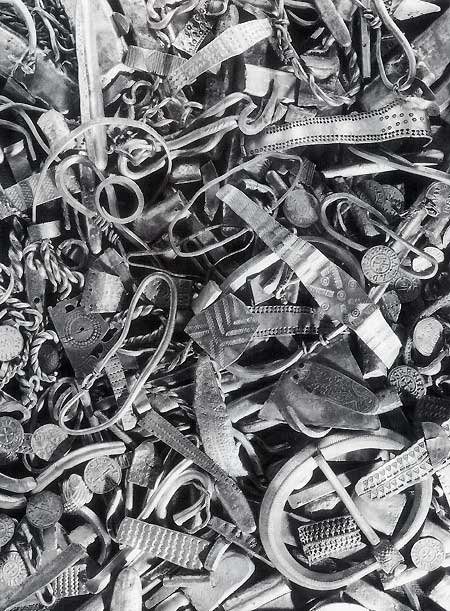
Cuerdale Hacksilver Hoard
 Attachment: 95.28 KB Attachment: 95.28 KB
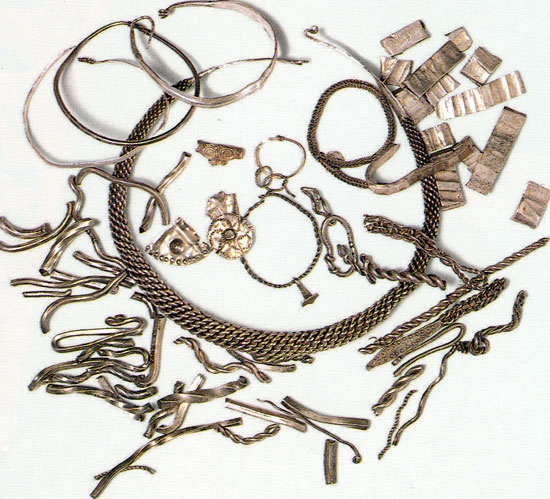
Two swords
Lit in Edenís flame
One of iron and one of ink
To place within a bloody hand
One of God or one of man
Our souls to one of
Two eternities
|
|
  |
 |
Thomas McDonald
myArmoury Alumni


|
 Posted: Sun 01 May, 2005 4:56 am Post subject: Posted: Sun 01 May, 2005 4:56 am Post subject: |
 |
|
You should write for CSI, Kirk ;-)
Interesting discussion, Mac
'Gott Bewahr Die Oprechte Schotten'
XX ANDRIA XX FARARA XX
Mac's PictureTrail
|
|
   |
 |
|
Patrick Kelly
|
 Posted: Sun 01 May, 2005 4:58 am Post subject: Posted: Sun 01 May, 2005 4:58 am Post subject: |
 |
|
| Quote: | | I think arguments from authority have some merit, but they seem to shut down any future discussion especially those lurkers who would not consider themselves "authorities". |
I don't see anyone here as an "authority", including myself. We're just a bunch of sword geeks.  Logic and evidence are the only concrete things we have to formulate beliefs with. Anything else sends us round and round in an endless circle of debate. Where's the controversy? This just looks like an interesting discussion to me. Logic and evidence are the only concrete things we have to formulate beliefs with. Anything else sends us round and round in an endless circle of debate. Where's the controversy? This just looks like an interesting discussion to me.
| Quote: | | "they would not surrender valuable swords to the ages, whereas a strand or two of silver wire was too valuable to lose." |
Actually this is the correct quote:
| Patrick Kelly wrote: | Everything from belt fittings to butt caps have been found. Nor were weapons the only things put into bog deposits. Logically there's no reason why these items would have been surrendered to the ages whereas a strand or two of silver wire was too valuable to lose.
|
We need to take all of these items in their totality, that makes the intentional removal of "valuable" silver wire even stranger.
As excellent as it is I don't think we can use Peirce's book as a gauge. There are more surviving swords from the viking age than those pictured in Peirce's book. He chose to illustrate swords that were good examples of their type or were in relatively good condition. They shouldn't be seen as every viking sword remaining.
Given the lack of evidence I think the best guesses we can make are "could be", "maybe", or simply "I don't know". It makes for interesting discussion though.
"In valor there is hope.".................. Tacitus
|
|
   |
 |
Kirk Lee Spencer

|
 Posted: Sun 01 May, 2005 5:26 pm Post subject: Posted: Sun 01 May, 2005 5:26 pm Post subject: |
 |
|
Hey Patrick...
Great points all around 
ks
Two swords
Lit in Edenís flame
One of iron and one of ink
To place within a bloody hand
One of God or one of man
Our souls to one of
Two eternities
|
|
  |
 |
|
|
You cannot post new topics in this forum
You cannot reply to topics in this forum
You cannot edit your posts in this forum
You cannot delete your posts in this forum
You cannot vote in polls in this forum
You cannot attach files in this forum
You can download files in this forum
|
All contents © Copyright 2003-2024 myArmoury.com — All rights reserved
Discussion forums powered by phpBB © The phpBB Group
Switch to the Basic Low-bandwidth Version of the forum
|

